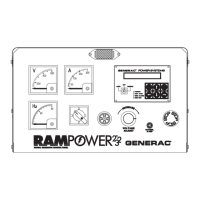Study these SAFETY RULES carefully before
installing, operating or servicing this equipment.
Become familiar with this manual and all literature
pertaining to your generator set and related equip-
ment. This equipment can operate safely, efficiently
and reliably only if it is properly installed, operated
and maintained. Many accidents are caused by failing
to follow simple and fundamental rules or precau-
tions.
Generac cannot possibly anticipate every possible cir-
cumstance that might involve a hazard. The warn-
ings in this manual, and on tags and decals
affixed to your equipment are, therefore, not
all-inclusive. If you use a procedure, work method or
operating technique Generac does not specifically rec-
ommend, you must satisfy yourself that it is safe for you
and others. You also must make sure the procedure,
work method or operating technique that you choose
does not render the equipment unsafe.
GENERAL HAZARDS
• For safety reasons, Generac recommends that this
equipment be installed and serviced by a Generac
Authorized Service Dealer or other competent, quali-
fied electrician or installation technician who is famil-
iar with applicable codes, standards and regulations.
The operator also must comply with all such codes,
standards and regulations.
• When working on this equipment, remain alert at all
times. Never work on the equipment when you are
physically or mentally fatigued.
• Inspect the equipment regularly, and promptly repair
or replace all worn, damaged or defective parts using
only factory-approved parts.
• Before performing any maintenance on the generator
or any related equipment, disable the generator to
prevent accidental start-up. Remove the control
panel fuse and then disconnect the battery cables by
removing the one indicated by a NEGATIVE, NEG or
(–) first. To re-enable the generator, reconnect the
battery cables connecting the one indicated by a
NEGATIVE, NEG or (–) last, then re-install the con-
trol panel fuse.
ELECTRICAL HAZARDS
• Generators produce dangerous electrical voltages
and can cause fatal electrical shock. Avoid contact
with bare wires, terminals, connections, etc., while
the generator and related equipment are running.
Ensure all appropriate covers, guards and barriers
are in place before operating the equipment. If you
must work around an operating unit, stand on an
insulated, dry surface to reduce shock hazard.
• Do not handle any kind of electrical device while
standing in water, while barefoot, or while hands or
feet are wet. DANGEROUS ELECTRICAL SHOCK
MAY RESULT.
• If people must stand on metal or concrete while
installing, operating, servicing, adjusting or repairing
this equipment, place insulative mats over a dry
wooden platform. Work on the equipment only while
standing on such insulative mats.
• Wire gauge sizes of electrical wiring, cables and cord
sets must be adequate to handle the maximum elec-
trical current (ampacity) to which they will be sub-
jected.
• Before installing or servicing this equipment, make
sure that all power voltage supplies are positively
TURNED OFF at their source. Failure to do so will
result in hazardous and possibly fatal electrical
shock.
• When installed with an automatic transfer switch, the
generator may crank and start anytime without
warning. To prevent injuries caused by sudden start-
up, disable the generator’s automatic start circuit
before working on or around the unit. Then, place a
“Do Not Operate” tag on the generator control panel
and on the transfer switch.
• In case of accident caused by electric shock, imme-
diately shut down the source of electrical power. If
this is not possible, attempt to free the victim from
the live conductor. AVOID DIRECT CONTACT WITH
THE VICTIM. Use a nonconducting implement,
such as a rope or board, to free the victim from the
live conductor. If the victim is unconscious, apply
first aid and get immediate medical help.
• Never wear jewelry when working on this equipment.
Jewelry can conduct electricity resulting in electric
shock, or may get caught in moving components
causing injury.
FIRE HAZARDS
• For fire safety, the generator and related equipment
must be installed and maintained properly.
Installation always must comply with applicable
codes, standards, laws and regulations. Adhere
strictly to local, state and national electrical and
building codes. Comply with regulations the
Occupational Safety and Health Administration
(OSHA) has established. Also, ensure that the
equipment is installed in accordance with the man-
ufacturer’s instructions and recommendations.
Following proper installation, do nothing that
might alter a safe installation and render the unit
in noncompliance with the aforementioned codes,
standards, laws and regulations.

